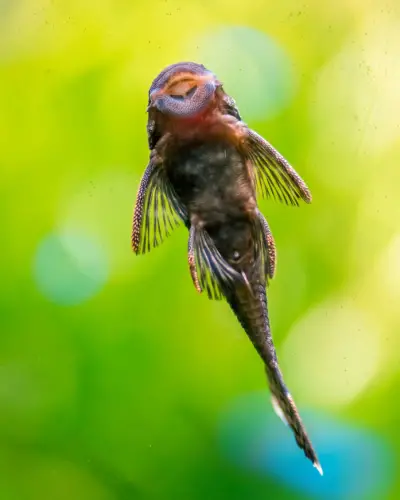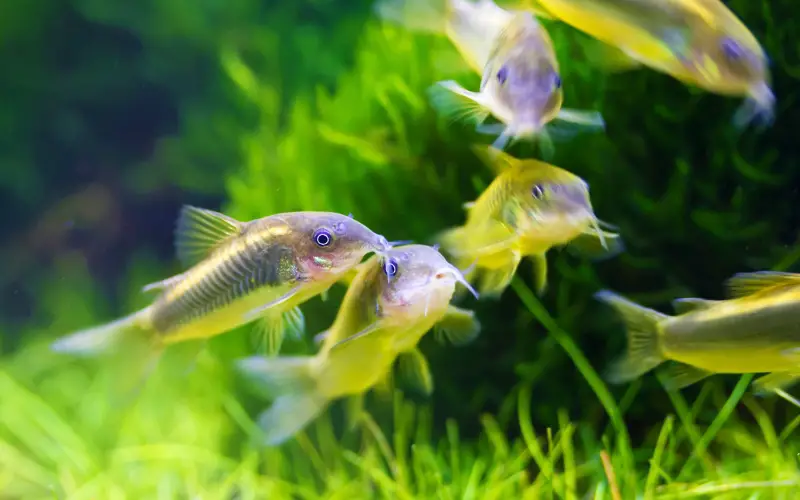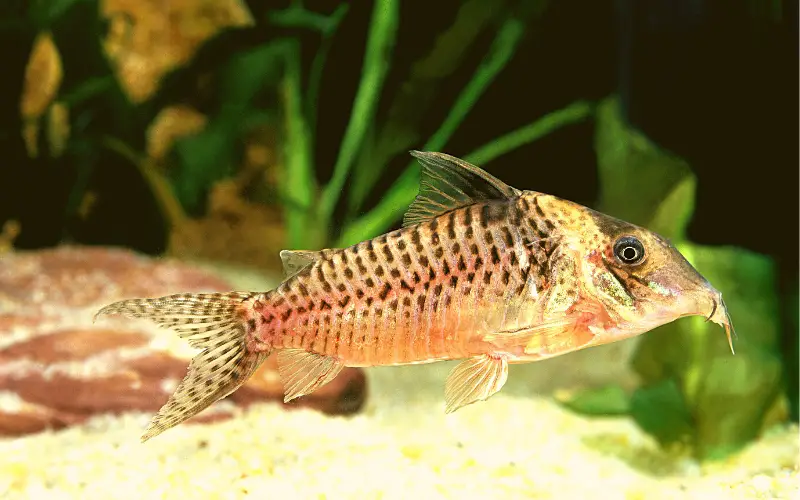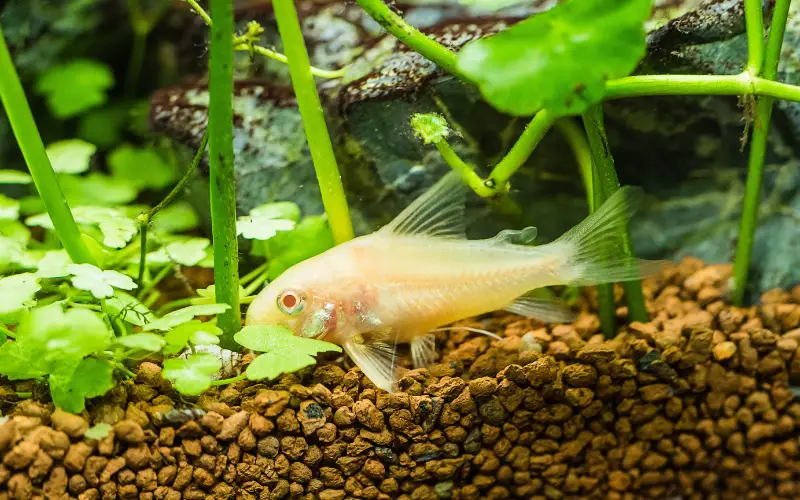Why are my Cory catfish swimming up and down? Have you ever noticed your Corydoras swimming up and down glass in your aquarium, almost as if they’re racing or searching for something? This peculiar behavior often leaves fishkeepers puzzled and worried.
While it can seem like a quirky trait, this repetitive swimming pattern is actually a form of communication from your Corydoras. They might be trying to signal that something is off in their environment—most commonly, a lack of oxygen.
Understanding what drives this behavior can help you take action to ensure your fish thrive in a healthy and balanced tank. The most likely reason your Corydoras are swimming up and down the glass is a lack of oxygen in the water.
Corydoras, like all fish, need sufficient oxygen levels to breathe and maintain their health. If the oxygen levels drop, they may resort to gulping air at the surface or exhibit restless swimming along the tank walls.

Addressing this involves checking your aquarium’s filtration and aeration systems and ensuring proper water circulation to promote oxygenation. Solving this issue promptly will not only stop the frantic swimming but also create a safer, more comfortable habitat for your beloved fish.
Stay tuned as we dive deeper into what your Corydoras’ behaviors mean and how to address them effectively!
Table of Contents
ToggleWhy do Corydoras swimming up and down in water?
Corydoras are known for their unique swimming behavior in the water, which can be attributed to a few different reasons. One of the main reasons is that this fish swimming behavior helps them with respiration.
Corydoras are a type of catfish with a specialized air-breathing organ called a labyrinth that allows them to breathe atmospheric air. By swimming up to the surface and back down to the bottom, they can take in gulps of air, which they need to supplement their oxygen intake.

Swimming in this manner also allows them to scavenge for food more effectively. By constantly moving through different water levels, they can search for food particles that may have settled at different depths.
This behavior can also be a form of social interaction amongst a group of Corydoras, as it has been observed that they often swim together in the same manner. Overall, the up-and-down swimming behavior of Corydoras serves both practical and social purposes for these fascinating fish.
Reasons Corydoras Swimming Up and Down Glass
Corydoras catfish are popular aquarium fish known for their peaceful nature and exciting behavior. However, one behavior that can be concerning for some keepers is when Corydoras swims up and down the glass. This Cory glass surfing behavior, known as glass surfing, can be caused by several factors.
– Water Parameter Issues
Corys swimming up and down glass due to water parameter issues such as high ammonia levels, poor water quality, or inadequate oxygen levels. These stressors can cause fish to exhibit erratic swimming behaviors as they try to find areas with better conditions. It is essential to regularly use a test kit to maintain appropriate water parameters for the health of the aquarium inhabitants.
– Incompatible Tank Mates
Corydoras, a peaceful bottom-dwelling fish, may swim up and down the glass due to stress caused by incompatible tank mates. Aggressive or territorial fish can cause distress and prompt the Corydoras to seek refuge higher up in the tank. To prevent this behavior, carefully research and select compatible tank mates for your Corydoras.
– Overcrowded Fish Tank
Corydoras may exhibit abnormal behaviors in an overcrowded fish tank, such as swimming up and down the glass. This is often a sign of stress and the fish’s attempt to find more space or escape from aggression. It is vital to ensure the tank is sized correctly and stocked to prevent such behaviors.
– Tank Conditions for Cory Cats
Corydoras cats need a well-maintained tank with clean water, hiding spots, and soft substrate. If they are swimming up and down the glass, it could be due to stress, inadequate tank conditions, or seeking food. Ensure the tank has proper parameters and sufficient space for them to explore and feel secure.
– Seeking air
Corydoras catfish have an air-breathing organ called an intestinal air sac that allows them to supplement their oxygen intake by gulping air at the surface. This is why they sometimes swim up to the top of the tank and quickly consume before returning to the bottom.
– Exploring their surroundings
Corydoras are naturally curious creatures and may explore their new environment. They may swim up to the top of the tank to get a better look or swim up and down the glass to see what’s going on on the other side.
– Stress
If Corydoras are stressed, they may swim up and down the glass to release stress. This is more likely to happen if the tank is too small, if there are too many fish in a community tank, or if the water quality could be better.
– Hungry or searching for food
Corydoras are bottom feeders, but they will sometimes swim up to the top of the tank to look for food if they are hungry or if there is not enough food available at the bottom of the tank.
Here are some tips for preventing Corydoras from glass surfing:
- Make sure the tank is large enough. Corydoras need at least 10 gallons of water per fish and should be kept in groups of at least 5.
- Maintain good water quality. Regularly test the water for ammonia, nitrite, and nitrate, and do water changes as needed.
- Provide hiding places. Corydoras like to have places to hide, so add rocks, caves, and plants to the tank.
- Feed them a variety of food. Corydoras are omnivores, so they should be fed a diet of both plant-based and meat-based foods.
- Monitor for signs of stress. If you notice your Corydoras swimming up and down the glass excessively or exhibiting other signs of stress, such as hiding or darting around, investigate the cause and take steps to correct it.
Following these tips can help your Corydoras live a happy and healthy aquatic life in your aquarium.
Why Is My Cory Catfish Swimming Crazy?
It could indicate a few issues if your Cory catfish swims erratically or wildly. Firstly, check the water parameters in your fish tank, as poor water quality can stress out fish and cause erratic behavior.
Ensure that the water is adequately filtered and that ammonia and nitrate levels are within acceptable ranges. Additionally, the fish may display erratic behavior due to stress or a lack of hiding spots in the tank.

Providing plenty of hiding spots, such as caves or plants, can help alleviate stress for your Cory catfish. It’s also essential to observe the fish for other symptoms of illness, such as unusual spots on the body, loss of appetite, or rapid breathing.
If you notice any other symptoms, it may be best to consult a veterinarian specializing in fish. Monitoring water quality and providing a stress-free environment for your Cory catfish can help address erratic swimming behavior.
Why Is My Cory Catfish Glass Surfing?
Glass surfing in Cory Catfish is a behavior that may indicate various factors affecting their well-being. Here are some possible reasons why your Cory Catfish might be glass surfing:
Stress:
- Changes in the aquarium environment, such as sudden water parameter fluctuations, new tank mates, or changes in lighting, can stress Cory Catfish.
- Make sure the water conditions are stable and suitable for your fish. Check temperature, pH, ammonia, nitrite, and nitrate levels.
Inadequate Tank Size: Cory Catfish need a sufficient tank size with appropriate hiding spots and swimming space. Inadequate space may cause stress and lead to glass surfing.
Lack of Hiding Places: Cory Catfish are naturally shy and appreciate hiding places like plants, caves, or decorations. A lack of hiding spots can make them feel exposed and stressed.
Aggressive Tankmates: Aggressive fish or territorial tankmates can stress out Cory Catfish, leading to Corydoras glass surfing. Ensure compatibility among the fish species in your aquarium.
Improper Water Conditions: Cory Catfish prefer clean and well-oxygenated water. Poor water quality, low oxygen levels, or high ammonia concentrations can induce stress.
Temperature Fluctuations: Sudden temperature changes can stress fish. Ensure that the temperature in the aquarium remains stable and within the recommended range for Cory Catfish.
Disease or Parasites: Illnesses or parasites can cause discomfort and stress, prompting unusual behaviors like glass surfing. Monitor your fish for signs of disease and quarantine if necessary.
Lack of Proper Diet: Ensure that your Cory Catfish are receiving a well-balanced diet. Poor nutrition can contribute to stress and abnormal behaviors.
To address reasons of Corydoras glass surfing, start by checking and maintaining stable water conditions. Provide hiding spots, ensure a suitable tank size, and observe the interactions between your Cory Catfish and other tankmates. If the behavior persists or you notice any signs of illness, consider consulting a vet or experienced aquarium professional for further assistance.
What is the normal swimming behavior of cory catfish?
Cory catfish are known for their active and social swimming behavior. In a home aquarium, they can often be seen darting around the bottom of the tank, scavenging for food, and exploring their environment.

Also new fish swimming at top of tank for air, as they possess a specialized organ called the labyrinth organ, which allows them to breathe atmospheric air. Cory catfish are shoaling fish, which means they thrive when kept in groups of at least six individuals.
They will exhibit even more active swimming behavior in a group, often seen darting and playing together. However, they can also be observed resting on the bottom of the tank during periods of inactivity.
Overall, the normal swimming behavior of Cory catfish involves a combination of foraging, exploring, and socializing, making them an engaging and entertaining species to observe in a home aquarium setting.
Why Do Corydoras Swim to the Surface?
Why does my Cory catfish swim to the surface? Cories swim to the water’s surface for a few reasons. One of the main reasons is to gulp air. Corydoras are part of a group of labyrinth fish with a particular organ that allows them to use atmospheric air.
When the water in their natural habitat becomes oxygen-depleted, they use this organ to breathe air from the surface, allowing them to survive in low-oxygen conditions. Another reason Corydoras may swim to the surface is to search for food.
In the wild, they feed on insects and plants that may float on the top of the water. By swimming to the surface, Corydoras can forage for these food sources.
Overall, swimming to the surface is an essential behavior for Cories, allowing them to breathe and feed in their natural habitat.
Are Cory Catfish Sensitive To Water Changes?
Yes, Cory Catfish are sensitive to water changes. They are more susceptible to sudden changes in temperature, pH, and hardness than other types of fish.
When performing water changes, it is essential to do so gradually and to use water as close to the same temperature and pH as the aquarium water. You should also avoid adding too much new water at once and perform smaller water changes more frequently.
Here are some tips for performing water changes for Cory Catfish:
- Use a water conditioner to remove chlorine and chloramine from the new water.
- Match the new water’s temperature to the aquarium water’s temperature.
- Add the new water slowly to the aquarium.
- Avoid adding too much new water at once.
- Perform smaller water changes more frequently.
By following these tips, you can help to keep your Cory Catfish healthy and happy.
What to Do When You Find Cory Cats Swimming All over the Tank?
Your Cory cats might be swimming all over the tank for a few reasons. Here are some of the most common causes and what you can do about them:
Low oxygen levels: Cory cats are bottom-dwelling fish that prefer to stay at the bottom of the tank. If they are swimming all over the tank, it could be a sign that there is not enough oxygen in the water. Several factors, such as an overcrowded tank, a dirty filter, or a lack of water circulation, can cause this. To increase the oxygen levels in your tank, you can do the following:
- Perform a partial water change to remove waste products and add fresh, oxygenated water.
- Clean your filter to remove debris clogging and prevent water from flowing correctly.
- Add an air bubbler or airstone to the tank to increase the water’s surface area, allowing more oxygen to be absorbed.
Stress: Cory cats can also become stressed if they are introduced to a new environment, if they are not compatible with their tank mates, or if their tank conditions are not ideal. If your cory cats swim erratically or dart around the tank, they may be stressed. To reduce stress in your cory cats, you can do the following:
- Introduce them to their new environment gradually.
- Choose tank mates that are compatible with cory cats.
- Ensure your tank conditions, such as water temperature, pH, and hardness, are within the ideal range for cory cats.
Food anticipation: Cory cats are opportunistic feeders and often come to the water’s surface when they are expecting food. If you have recently fed your cory cats or are in the habit of providing them at the same time each day, they may be swimming up to the surface in anticipation of food. This is normal behavior, and worrying about it is unnecessary.
Exploration: Cory cats are curious creatures and will often spend their time exploring their surroundings. This includes swimming all over the tank, even in the upper levels. If your Cory cats are swimming around and seem to be exploring their surroundings, there is no need to worry about it.
If you are concerned about your Cory cats’ swimming behavior, consulting an experienced aquarist or fish veterinarian is always best. They can help you determine the cause of the problem and recommend the best course of action.
keeping Cory catfish important tips
Cory catfish are peaceful, bottom-dwelling fish that are popular among aquarium hobbyists. They are relatively easy to care for and can be a great addition to a community tank. Here are some essential tips for keeping Cory catfish:
- Tank size: Cory catfish are social fish and should be kept in groups of at least six. A 20-gallon tank is the minimum size for a group of six Cory catfish, but a larger tank is always better.
- Water parameters: Cory catfish prefer water with a pH between 7.0 and 8.0, an alkalinity between 3° and 10° dKH (54ppm to 180ppm), and a temperature between 74° and 80°F.
- Filtration: Cory catfish are not too demanding regarding filtration, but they need a good filter to keep their water clean. A sponge or under gravel filter is a good choice for Cory catfish.
- Substrate: Cory catfish spend a lot of time foraging on the bottom of the tank, so it is crucial to have a soft and smooth substrate. Sand or fine gravel is the best choice for Cory catfish. Avoid jagged materials that could damage their barbels.
- Food: Cory catfish are omnivores and eat various foods, including flakes, pellets, and live or frozen foods. They are particularly fond of sinking foods like wafers and algae wafers.
- Water changes: Cory catfish are not as sensitive to water changes as some other fish but need their water to be changed regularly. A 10% water change every week or two is sufficient.
- Decoration: Cory catfish are not too picky about decoration but appreciate plants and hiding places in their tank. Plants will help to oxygenate the water and provide hiding places for the fish. Hiding places can be made with rocks, driftwood, or ceramic caves.
- Temperament: Cory catfish are peaceful fish that are compatible with a wide variety of other fish. They are not aggressive and will not bother other fish in the tank.
With proper care, Cory catfish can live for 5-10 years. They are a rewarding fish to keep, bringing you years of enjoyment.
Commonly Asked Questions about Cory catfish are swimming up and down in water (FAQs)
Why is my Corydora swimming up and down?
Corys are known for their playful behavior; swimming up and down the glass is an everyday activity. Seeing your Cory catfish swimming up and down more frequently than usual could be a sign of stress or poor water conditions.
When Cory Catfish Darting to Surface?
Cory catfish dart to the surface to gulp air because they have a specialized organ called an intestinal lung that allows them to extract oxygen from the air. This is normal behavior for Cory catfish, but if they dart to the surface frequently, it could indicate low oxygen levels in the water.
Why is my Cory catfish swimming like crazy?
There are a few reasons why your Corydoras swimming erratically up and down. It could be due to stress, poor water quality, or a parasite infection. If you notice your Cory catfish swimming erratically, it’s essential to investigate the cause so that you can take corrective action.
Why Is My Cory Catfish Swimming Around So Much?
Cory catfish are naturally active fish and enjoy exploring their surroundings. However, excessive swimming could indicate stress, poor water quality, or a food search. Monitor your Cory catfish’s behavior and water parameters to determine the underlying cause.
Why do Cory catfish swim up and down the glass?
Cory catfish may swim up and down the glass due to territorial behavior, curiosity, or seeking food. Ensure proper tank conditions and enrichment to address these instincts.
Why is my catfish going up and down the tank?
Catfish swimming up and down the tank could be due to stress, poor water quality, or a search for food. Monitor your catfish’s behavior and water parameters to determine the cause.
What is normal Cory catfish behavior?
Cory catfish are peaceful, bottom-dwelling fish that spend their days scavenging for food and exploring the substrate. They are known for their playful personalities and enjoy swimming in groups.
How do you stop fish glass surfing?
To stop fish glass surfing, ensure optimal water conditions, provide adequate enrichment, and avoid overstocking.
How do you fix fish glass surfing?
To fix fish glass surfing, assess water parameters, provide hiding spots, enrich the tank with plants and decorations, and maintain a consistent feeding schedule. Addressing stressors can help alleviate this Cory glass surfing behavior.
How to tell if Corydoras are happy?
Happy corys are active, eat regularly, exhibit normal coloration, and school together. Assess their behavior, appearance, and appetite to gauge their well-being.
Why Are My Cory Catfish Swimming at the Top of My Tank?
Why is my Cory catfish swimming at the top of the tank? Cory catfish typically inhabit the bottom of the tank but may swim to the top for various reasons, including low oxygen levels, stress, or scavenging for food.
Why does my Cory swim up and down the side of the tank?
Why do corys swimming up and down? Cory catfish may swim up and down the tank due to territorial marking, curiosity, or seeking food. Ensure proper tank conditions, provide hiding spots, and diversify their diet for enrichment.
Why is my Cory catfish swimming against glass?
why is my catfish swimming up and down? Cory catfish swimming against the glass can be a sign of stress, poor water quality, or a lack of suitable hiding spots. Check water parameters, provide more hiding places, and ensure the tank environment is calm.
Why does my panda Cory swimming up and down?
Panda Corydoras exhibit this behavior for several reasons: exploring their environment, seeking food, or reacting to water quality issues (like insufficient oxygen). Observe water parameters.
Why is my fish swimming up and down the glass?
Fish swimming up and down the glass may be stressed, ill, or seeking attention. Check water quality, tankmates, and ensure adequate space. Observe for other symptoms.
Why does my new fish swimming up and down glass?
New fish often swim near the glass exploring their environment. However, constant glass-hugging could signal stress, poor water quality, or illness. Monitor closely.
Conclusion
So, why do Cory fish swimming up and down glass? In conclusion, observing the mesmerizing movements of aquarium fish can bring a sense of tranquility and wonder to our lives. The graceful dance of Cory’s catfish as they swim up and down the glass is a sight to behold. Their synchronized motion and delicate fins create a soothing visual symphony, captivating both young and old alike. Whether you’re a seasoned fish enthusiast or simply seeking a moment of serenity, the enchanting sight of Corydoras swimming up and down glass will leave you in awe. So, dive into the world of aquatic beauty and let the Corydoras catfish enchant you with their captivating display.
You might also like
- How Fast Do Cory Catfish Grow? Let’s Clear Up the Confusion
- 7 Best Types of Catfish for Aquarium: Boost Your Tank Beauty
- Unbelievable Cory Catfish Behavior: Is It Good or Bad?
- Cory Catfish Laying on Side: (Top 5 Reasons & Solutions)
- Cory Catfish Glass Surfing: (Reasons & 5 Rapid Solutions)
- Hastatus Corydoras 101: Tail Spot Pygmy Cory Ultimate Guide
- Loxozonus Corydoras 101: A Comprehensive Beginner Guide
- Where to Buy Vintage Cory Catfish Weitzmani (Ultimate Guide)




